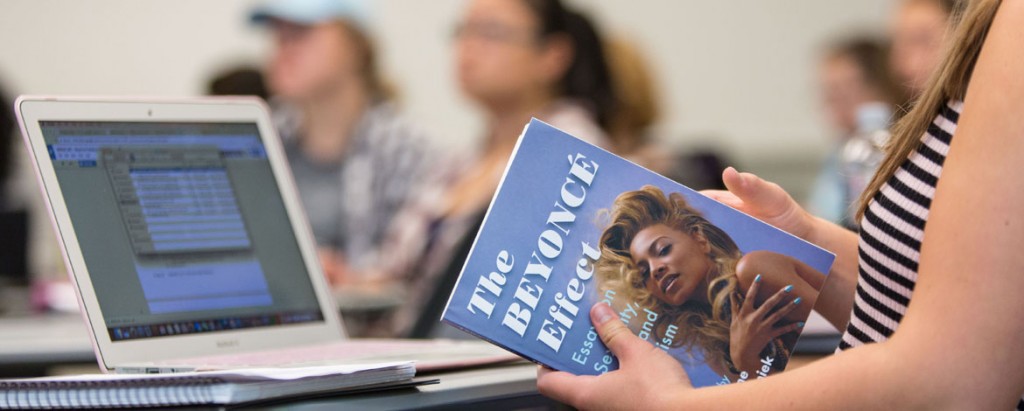Page 26 • (277 results in 0.093 seconds)
-

have access to these artifacts and share them with students,” Marcus said. The course will consist of critical readings of texts from Holocaust survivors and children of survivors. Students will examine the Holocaust within fiction, asking questions such as “how should the Holocaust be represented?” and “who gets to tell those stories?” While students are reading the literature, they will interact with artifacts. The goal is to deepen understanding and foster empathy from students about the trauma
-
(2000), co-edited with Dr. Hester Baer, a critical edition of a Holocaust memoir originally published in Germany in 1946. Experience and Expression: Women, the Nazis, and the Holocaust (2003), co-edited with Dr. Myrna Goldenberg, an anthology of essays on gender and the Holocaust. The Golem Redux: from Prague to Post-Holocaust Fiction (2012), which traces the intertextual appropriation of the golem legend in contemporary Jewish-American fiction, graphic novels, comics, The X-Files, and films. The
-
three-year, four-residency program in poetry, fiction, and creative nonfiction. The Rainier Writing Workshop is a community of talented, mature, and independent writers, working in an atmosphere in which each writer’s work deepens and flourishes.Jasminne Mendez '21 Talks About the PLU Rainier Writing Workshop (MFA Program)The Rainier Writing Workshop is PLU’s MFA in creative writing program. It is the Pacific Northwest’s premier low-residency Master of Fine Arts in creative writing.Master of Arts in
-
presentation of non-fiction multimedia stories. In addition, students will learn to evaluate various multimedia products. Prerequisite: COMA 215 or consent of instructor. (4) COMA 344 : Multimedia Production Course incorporates contemporary methods, styles and formats used in production and editing for multimedia products. Students will oversee development and design of non-fiction multimedia presentations while adhering to professional standards of media structure. Prerequisite: COMA 101, 215 or consent
-
week’s and suggest anything he wanted me to go look up. He usually assigned a theme of each paper but was pretty flexible on direction of paper. Selected bibliography: Anderson, Patricia. The Printed Image and the Transformation of Popular Culture, 1790-1860. Oxford: Clarendon Press 1991. Hack, Daniel. The Material Interests of the Victorian Novel. Charlottesville; London: University of Virginia Press 2005. Payne, David. The Reenchantment of Nineteenth-Century Fiction: Dickens, Thackeray, George
-
strives to choose the most cost-effective option, balanced with the other selection criteria. Curated collections. Popular Fiction Collection Policy Faculty publications: The library accepts both donations of works by faculty and suggestions for purchase. Alumni and student publications: The library accepts both donations of works by alumni and current students, and suggestions for purchase. Archives Collection Policy Textbooks.As a general rule, the library does not purchase course textbooks. Our
-
-gay prejudice on campus and in the larger society. His contributions to the ongoing process of making PLU “queer friendly” continue to resonate strongly and will never be forgotten. As a scholar, Tom’s work reflects his multitudinous interests and commitments. A regular contributor to the Magill Book Review for twenty-five years, Tom, always with his inimitable point of view and lively prose, has reviewed gay and lesbian literature, AIDS literature, personal writing, literary history, and fiction
-

relations. [video: Dr. Young’s voice continues over clips. A student videotapes a speaker who gestured to the background of buildings behind him. A speaker is interviewed by students who videotape. A professor interviews a panel for medialab.] Dr. Young: They also make one long form non-fiction documentary a year. And in the last eight years have been nominated four times for Emmys in the college division. [video: Return to Isaiah in the classroom.] Isaiah: Hearing about what MediaLab did just pretty
-
. Although intended to shock, Charles’s spurious character was present in early episodes, and not just through the ton’s discomfort with his eccentricity. His applications to paint Georgiana (Crystal Clarke) seem altruistic, yet they display an underlying misogynoir that limits her self-expression. In the context of Sanditon’s historical fiction, Georgiana’s power over the portrayal of her image resonates with modern expressions of beauty and even ongoing legislation about hairstyles. While Lockhart’s
-
with student media and MediaLab, where she edited an award-winning documentary about higher education in America titled “These Four Years.” She loves cats, science fiction and a good cup of coffee. VOLUME 3, ISSUE 3 RESOLUTE is Pacific Lutheran University’s flagship magazine, published three times a year. EDITORIAL OFFICES PLU, Neeb Center Tacoma, WA 253-535-8410 Contact Us Links Features On Campus Discovery Class Notes ResoLute Staff Recent Articles Personal Journey September 13, 2016 The Rev. Jen
Do you have any feedback for us? If so, feel free to use our Feedback Form.


